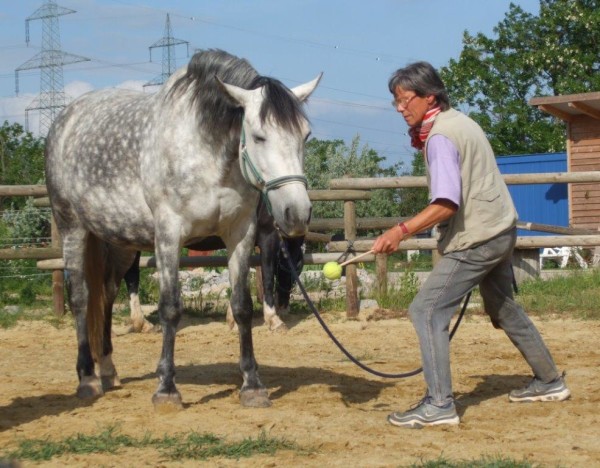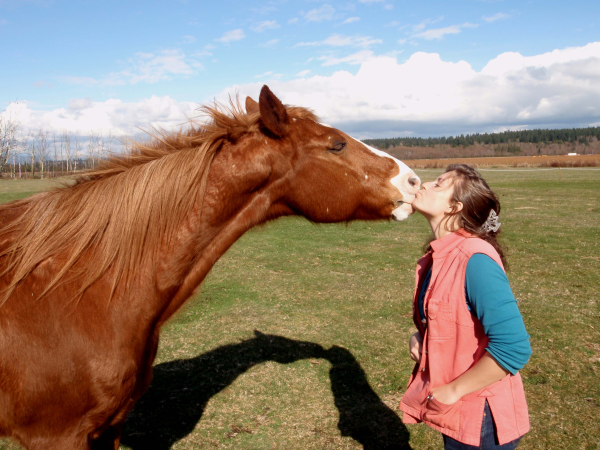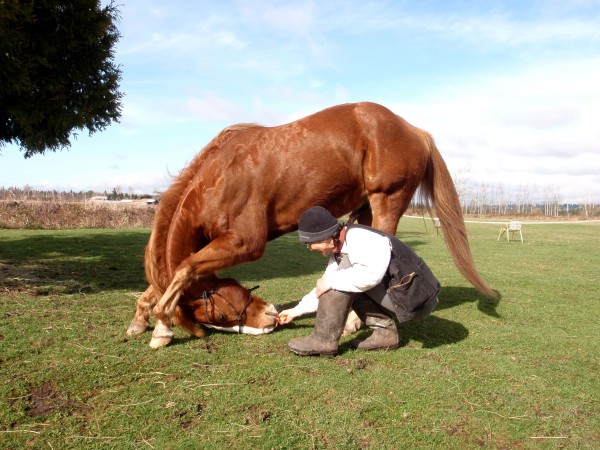- In the last Blog we touched upon the differences between the human and the horse’s brain. Naturally this has huge consequences on how we have to structure our training, if we want to be efficient teachers.
Humans are bad observers:
- We are bad observers, because our brain filters out all details which do not seem important in the present situation. The flight animal horse however sees the world as if in a consecutive row of individual pictures, like in a film, in which each of those pictures might be the one impression accountable for the survival at that moment. His brain registers everything – but does not generally retain connections between individual observations and does not draw logical conclusions. As he observes in in great detail, nothing of our body language escapes him!
Potential problems with signals:
- This becomes a very important point for our training, since we communicate with our pupil via signals (mostly words on which we rely way too much). But we are not aware of many of the signals we send unconsciously, and really confuse our horse!
- The horse notices all of our body language, and when our gestures, the intonation and our word commands contradict each other, then it should not be surprising that the horse cannot find the right solution of a set task.
|
|
- Im letzten Blog haben wir kurz angesprochen, daß und wie das menschliche Gehirn sich von dem des Pferdes unterscheidet. Das hat natürlich eine große Auswirkung darauf wie wir es trainieren müssen, wenn wir effektive Ausbilder sein wollen.
Menschen sind schlechte Beobachter:
- Wir sind schlechte Beobachter, weil unser Hirn alles, was für die momentane Situation nicht wichtig scheint, ausfiltert. Das Fluchttier Pferd dagegen, sieht die Welt in lauter aufeinander folgenden Bildern, wie einen Film, in dem jedes Bild der für das Überleben wichtigste Eindruck sein könnte! Sein Gehirn registriert alles – merkt sich aber keine generellen Zusammenhänge zwischen solchen Einzelbeobachtungen und zieht keine logischen Schlüsse. Da es also ganz detailliert beobachtet, entgeht ihm aber keine Einzelheit unserer Körpersprache!
Problematische Signale:
- Das wird ein ganz wichtiger Punkt für unser Training: denn wir kommunizieren mit unserem Schüler via Signale (meistens Worte, auf die wir uns viel zu viel verlassen). Wir bemerken aber viele Signale, die wir unbewußt geben, selber gar nicht und verwirren unser Pferd total!
- Denn dem Pferd entgeht von unserer Körpersprache nichts, und wenn unsere Gesten, unser Tonfall und unser Wortkommando sich widersprechen, dann ist es kein Wunder, daß das Pferd nicht die richtige Lösung der Aufgabe finden kann.
|
What does the horse say?
- The other problem is that, as the horse equally tries to communicate and therefore sends out signals, we often don’t even notice them and consequently do not understand them (review Blog series “Understanding your Horse”)
Word commands:
- In the Blog series „Lungeing“ part 03 and in the series „Your horse’s IQ“ part 12 we discussed word commands – how they have to be made up and how we have to make them meaningful for the horse by association, before one can assume that the horse understands them.
The danger of humanization:
- Apart from the fact that we rely on words too implicitly, we often make the mistake of humanizing our horses – of attributing emotions to them, which in actuality they might not feel at all. This can really get in the way of effective training! This is especially dangerous in problem situations: by assuming that the horse is “obstinate” for example, a trainer might excuse himself from looking for a mistake in his own training approach.
|
|
Was sagt das Pferd?
- Das andere Problem ist, daß ja auch das Pferd versucht zu kommunizieren und ebenfalls Signale gibt, die wir wiederum oft gar nicht bemerken und daher auch nicht verstehen. (siehe Blog Serie „Understanding your Horse“).
Wort Kommandos:
- In der Blog Serie „Longieren“ Teil 03 und in der Serie „IQ Ihres Pferdes“ im Teil 12 sind wir näher auf Wortkommandos eingegangen – wie sie beschaffen sein müssen und wie man sie durch Assoziation für das Pferd bedeutsam machen muß, ehe man sich auf ein Verständnis verlassen kann.
Gefahr der Vermenschlichung:
- Abgesehen von der Tatsache, daß wir uns zu sehr auf Worte verlassen, machen wir oft den Fehler unsere Pferde zu vermenschlichen – wir schreiben ihnen Emotionen zu, die sie in Wirklichkeit vermutlich gar nicht fühlen. Das kann effektivem Training wirklich in die Quere kommen! Besonders in Problemsituationen, wenn man als Trainer z.B. annimmt, das Pferd sei „widerspenstig“ und daher nicht nach einem Fehler in seiner Ausbildungsmethode sucht.
|
Emotions:
- Even among humans we cannot “know” what another person thinks or how he feels. Scientifically speaking we don’t know very much about the horse’s emotions, except that basic emotions such as fright/panic, anger/rage and curiosity/fun/joy seem to be similar as in humans. Of course affection/ friendship/feeling of security is a strong factor. So while training we want to leave out humanizing assumptions as much as possible and rather concentrate on observable behaviour.
Definition of “Teaching”:
- To avoid the above mentioned pitfalls of wrong interpretation of our horse’s reactions, we therefore want to teach according to the inborn learn-mechanisms of the horse – the universal principle of survival. “Good” for the horse is, what makes it possible for him and/or for his species to survive better, emotionally as well as physically.
A good teacher:
- observes the behaviour shown by the horse
- encourages it, if he likes it
- tries to change it, if he doesn’t
- and uses to that purpose the natural striving for better survival of the horse
- Using the inborn learning mechanism (E.W. calls them “fitness improvement”) has a positive influence on the psyche of animal and human alike. “Both experience the training success as a boost in motivation and this develops a strong bond of affection between the two” (E.W.)
|
|
Emotionen:
- Nicht einmal unter Menschen können wir „wissen“ was der andere denkt oder fühlt. Wissenschaftlich gesprochen wissen wir recht wenig über die Gefühle des Pferdes, außer daß die Grundemotionen wie Angst/Panik, Zorn/Wut und Neugier/Spaß/Freude ähnlich wie beim Menschen zu sein scheinen. Natürlich sind auch Zuneigung/Freundschaft/Sicherheitsgefühle wichtige Faktoren. Beim Training wollen wir also so weit wie möglich vermenschlichende Annahmen vermeiden und uns auf beobachtbares Verhalten konzentrieren.
Definition von „Lehren“:
- Um die oben erwähnten Fallgruben falscher Interpretation der Reaktionen unseres Pferdes zu vermeiden, wollen wir daher gemäß seiner angeborenen Lernmechanismen lehren – das sind die universellen Prinzipien des Überlebens. „Gut“ ist für das Pferd, was es ihm oder seiner Art hilft besser zu überleben, emotionell wie auch körperlich.
Ein guter Lehrer
- „Er beobachtet das gezeigte Verhalten.
- Wenn es ihm gefällt, fördert er es.
- Wenn es ihm nicht gefällt, versucht er, es zu ändern.
- Er nutzt dazu das natürliche Streben des Tieres nach „Fitnessverbesserung“.“ (E.W.)
- „Die Techniken des Lehrens, die angeborene Lernmechanismen nutzen, haben … einen positiven trainers. Beide erleben den Trainingserfolg als Motivationsverstärkung, und infolgedessen entwickelt sich ein Band der Zuneigung zueinander“ . (E.W.)
|
- How to change exercises, which are merely fun, into activities, which the horse considers as “fitness improvement” in the above mentioned sense, so the trainer can count on the animal’s cooperation, is the SECRET of the world’s best animal trainers.
The “SECRET” :
S stands for Science
- The laws of learning are consistently applied. These laws are the ABC of Learning, which we will discuss next. They are the Ten Laws of Shaping.
E stands for Empowerment.
- This means that the trainee is allowed to have an influence on the course of training. They have the freedom to avoid their trainer as well as the situation, if they please. Thus they can cooperate voluntarily.
C stands for Communication
- Communication must be mutual. Both parties must understand each other. The trainee learns signals, which are unambiguous and reliable. The trainer respects the animal’s answer and structures his training accordingly.
R stands for Respect
- The trainer understands that an unwanted behaviour of the animal is an expression of a need, the reason of which needs to be explored!
E stands for Enrichment
- We enrich the life of an animal, which we took prisoner, according to the possibilities of his species with interesting variety and mental stimulation.
T stands for Trust
- We must be accepted by the animal, if we want voluntary learning. We must therefore spend enjoyable quality time with him outside of training sessions and always show friendly and trustworthy behaviour.
To bring the training principles of the best trainers to the point:
1) They ignore undesirable behaviour and avoid punishment.
2) They spend quality time with the trainee.
3) They build a relationship of trust.
4) They start every lesson by reinforcing a
desirable behaviour which is show spontaneously by the animal.
5) They reward desirable behaviour instantly.
6) They reward desirable behaviour specifically, but otherwise do not “pamper” the trainee.
7) They teach in short sessions, raise demands in minimal increments and always structure the lesson in such a way that the pupil can be successful and the training is fun.
- We note that in none of the above points the stress lies on the training task itself! The emphasis is on the training environment to create a joyful learning situation.
- All in all quite a package, as we will see. Do not expect to become one of the world’s best trainers in three weeks – the implication of the above mentioned points on our day-to-day training will be much greater and more difficult than we think.
But they guaranty success!
- If and as long as we follow the steps as laid out in the book by Eva Wiemers, everybody will reach their goals for sure. This is more than any other book can promise – and I have personally tried it out.
In the next Blog we move on to the ABC of Learning!
Read on !!!
|
|
- “Wie man Übungen, die lediglich Spaß Machen, für das Tier “überlebenswichtig” macht, so daß man mit seiner Kooperation fast sicher rechnen kann, das ist das Geheimnis (SECRET) der weltweit erfolgreichsten Trainer“. (E.W.)
Das “SECRET” :
S steht für Science, Wissenschaft.
- Die Gesetze des Lernens werden konsequent angewendet. Diese Gesetze sind das ABC des Lernens, das wir gleich besprechen werden. Das sind die Zehn Gebote des Formens.
E steht für Empowerment, Selbstkompetenz
- Den auszubildenden Tieren ist erlaubt, auf den Ablauf Einfluß zu nehmen. Sie dürfen ihrem Trainer wie auch einer Situation ausweichen. So entscheiden sie sich freiwillig für die Mitarbeit.
C steht für Communication, Verständigung
- Die Verständigung muß wechselseitig sein. Beide Partner müssen sich verstehen. Der Schüler lernt Signale, die eindeutig und verläßlich sind. Der Ausbilder respektiert die Antwort des Tieres und stellt sein Training darauf ein.
R steht für Respekt
- Der Trainer versteht unerwünschtes Verhalten des Tieres als Ausdruck eines Bedürfnisses, dem auf den Grund gegangen werden muß!
E steht für Enrichment, Bereicherung
- Wir bereichern die Bedingungen des in Gefangenschaft lebenden Tieres und bieten ihm artgemäße Möglichkeiten der Abwechslung und geistigen Anregung.
T steht für Trust, Vertrauen
- Die Voraussetzung für freiwilliges Lernen ist vom Tier akzeptiert zu sein. Daher muß man erfreuliche „Qualitätszeit“ außerhalb der Trainingsstunden mit ihm verbringen und dabei immer freundliches und vertrauenswürdiges Verhalten zeigen.
Die Trainingsgrundsätze der erfolgreichsten Ausbilder auf den Punkt gebracht:
1) Sie ignorieren unerwünschtes Verhalten und vermeiden Strafen.
2) Sie verbringen Qualitätszeit mit dem Tier.
3) Sie bauen ein Vertrauensverhältnis auf.
4) Sie beginnen jede Lektion mit dem Verstärken eines spontan gezeigten, wünschenswerten Verhaltens.
5) Sie belohnen wünschenswertes Verhalten sofort.
6) Sie belohnen wünschenswertes Verhalten gezielt, ansonsten „verwöhnen“ sie nicht.
7) Sie lehren in kurzen Einheiten, steigern die Anforderungen in minimalen Schritten und gestalten die Lektion so, daß der Schüler erfolgreich sein kann ud das Training Spaß macht.
- Uns fällt auf, daß die Betonung in den obigen Punkten nicht auf einer geforderten Trainingsaufgabe liegt. Der Schwerpunkt liegt beim Schaffen eines Umfelds, das ein freudiges Mitmachen fördert.
- Alles in Allem ein schönes Paket, wie wir sehen werden. Erwarten Sie nicht in drei Wochen einer der weltbesten Trainer zu werden – die Auswirkung der oben genannten Punkte auf unser Training wird viel größer und schwieriger sein als wir hier annehmen.
Aber sie garantieren Erfolg!
- Solange wir die Schritte befolgen, die in Eva Wiemers‘ Buch für uns dargelegt sind, wird jeder von uns sein Ziel erreichen. Das ist mehr als viele andere Bücher versprechen können – und ich habe es persönlich ausprobiert.
Im nächsten Blog kommen wir zum ABC des Lernens!
Lesen Sie weiter !!!
|




